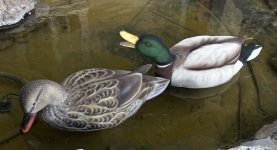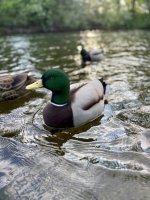You are using an out of date browser. It may not display this or other websites correctly.
You should upgrade or use an alternative browser.
You should upgrade or use an alternative browser.
tag team mallard
- Thread starter Don Mintz
- Start date
Capt Rich Geminski
Well-known member
Just a much fun doing decoys together as hunting!
I really enjoy working with my son, Caleb. He has a great work ethic and just enjoyable to be around. We've worked together since he got out of college in 2010 except for the past year and a half when he was working as a manager in the local Scheels. Low pay and long hours were beating him down, so he decided to come back to the decoy business. He hung around the shop all the time when he was a little boy, I've always worked at home. I have videos of him running my airbrush at age 7, 30 years ago. I've kept making decoys along the way figuring things out, new techniques, new processes with the help of my friend, William Reinicke. I can't believe how far we have come in just a couple of years. We just keep trying to make better hunting decoys. How far we have come from the simple beaded foam mallards my dad and I made almost 60 years ago to what we are making today, just think where we will be a year from now. I think I learn something new every day. These are the latest, just finished yesterday. I do the designs, Caleb does the molding, I do the customization and flocking, he does the airbrushing and with this group I enhanced his paint job with some detail.




Very nice, and what a great gift to be able to share this time with your son!
Last edited:
If I can be half the airbrusher you are one day, ill be perfectly content. Those hens are borderline too perfect to hunt.... but what am i saying, if htey aint hunted, what good are they on the shelf?
no such thing as too nice to hunt. The way I see it is a decoy is for hunting, not for display. I rarely carve a decoy for the shelf unless it's an urn and most urns I make are made to hunt a day or two a year. If I'm making something for the shelf, it will be an art piece, a flying duck, a caribou running across the tundra, a grayling leaping out of the water. If it's a decoy, it's going hunting. I'm pretty well consumed ,as you know, with always improving and innovating. Looking for new materials, lighter materials, tougher materials, better processes are continuing endeavors. Something changes in the process of making decoys on a monthly, weekly or even a daily basis. I know as you and I talk, sometimes I'll say something like "what will we be doing a month from now", just to message you back within the hour with a new discovery. The only thing that is probably traditional in my decoy making is using whatever is available to make a decoy out of. Making things pretty is fun for me and satisfies my artistic side. I hear lots of people talk about where decoys are on their list of important things. I don't have to be on the "X", but do need a few ducks around to play with, you don't need that many birds around to kill 7. So location is important and a good hide is a given, but my idea of a blind is overhead cover and a few tumbleweeds and a bucket to sit on. If there are a few ducks around and I have some cover we are golden. I'd not just say decoys are a help, they are critical. Having said that, I think a lot of folks kill ducks in spite of their decoys, not because of them. If your decoys don't make a dramatic difference in your ability to decoy ducks, you are using the wrong decoys.
Ronald Bock
Active member
I admire you and your sons artwork. My daughter and I are doing the same. We're trying to finish up a couple commission birds. Unfortunately summer... gardening, fishing, camping, swatting mosquitoes, gets in the way. Summer is short up here.
yes, I remember it well. those long summer days with no night make it hard to stop doing stuff, especially when you are only a few months away from going back to night. I remember when I had a friend come up from college and took him fishing out on the Chena. He told me he was going to fish until it was too dark to see, it was the fourth of july, he came dragging in at about 7am.
Ronald Bock
Active member
I've always used hollowed out wood decoys. Alot heavier but they ride different too. I ended up with a bunch of foam this year. Now Don has got me planning some foamers. I still hand paint. I admit I've looked at airbrushes. Just can't seem to give up my brushes.
This group is cool. Been learning from Don and William and many others. Thanks all.
This group is cool. Been learning from Don and William and many others. Thanks all.
Excited to see the foam stuff you come up with. Its fun, I just finished my first 18 for next season. A lot better than the birds I used last season. Going to get the next 18 hunters ready to go and then maybe make a dozen trade birds. Hopefully I can get all that done and get a few geese ready for next fowl season. If I can get that accomplished, ill be a happy man with my busy busy busy off season that has been so unexpected this year.I've always used hollowed out wood decoys. Alot heavier but they ride different too. I ended up with a bunch of foam this year. Now Don has got me planning some foamers. I still hand paint. I admit I've looked at airbrushes. Just can't seem to give up my brushes.
This group is cool. Been learning from Don and William and many others. Thanks all.
Don and son, Ron and Daughter.... two really good duos at decoy making. Im just happy if my ducks come out not looking like cartoons. If I remember, ill take some pics of this the finished birds this season and get them posted.
Ronald Bock
Active member
My daughter Jheri shipped out a cinnamon teal to North Carolina this morning. Shipping to/ from Alaska kills us but we'll get the birds to the customer somehow.Excited to see the foam stuff you come up with. Its fun, I just finished my first 18 for next season. A lot better than the birds I used last season. Going to get the next 18 hunters ready to go and then maybe make a dozen trade birds. Hopefully I can get all that done and get a few geese ready for next fowl season. If I can get that accomplished, ill be a happy man with my busy busy busy off season that has been so unexpected this year.
Don and son, Ron and Daughter.... two really good duos at decoy making. Im just happy if my ducks come out not looking like cartoons. If I remember, ill take some pics of this the finished birds this season and get them posted.
shipping is a killer. We had an account with Fedex for years and years with a little discount, but really not enough to help. Our yearly fedex bill was over $20k. This year we switched to pirateship.com and it's cut the shipping cost considerably, they give a few options of what's the least expensive. Usually UPS is best, often it will be UPS delivering to a post office and then to the house, but so far no issues and nothing broken. I don't have any idea how that would work for you up in northern wilderness, but we usually get a good deal. I shipped 5 mallards to long Island New York yesterday, a large heavy duty box and it cost $68. The same package is usually about $40 to the west coast from here in Idaho. Always a better deal than our "discount" on fedex.
I'll warn you about making custom foam decoys, you will be ostracized by the decoy making community. I still am after over 20 years. I just stay in my own lane these days and make hunting decoys. I still carve wood when it's something decorative, but really like the performance, versatility and durability of foam. Most people have no idea how I make decoys anymore other than William. There is no similarity between what we were doing a year ago, who knows where we will be a year from now. I don't like plastics, especially when they are made in a country that wants to destroy our country.
My plan for the summer was going to be making my son a dozen each of 16 species, 192 decoys by fall. That ain't going to happen. I've been flocking 20 to 60 decoys every day for weeks now with 200 decoys in front of me and really no end in sight. My son is now doing nearly all the airbrushing unless it's some of the more detailed stuff. I had about the same idea as you when I first started to contemplate airbrushing. I bought one when we lived in Fairbanks in 1981, used it a couple times and gave up. There was no one to ask for help, so I put it away for a year. I was trying to paint some fish I had mounted and there was just no other way, so I picked it up again. it takes a bit to catch on, kind of like rubbing your tummy and patting your head. Soon it clicks and you'll wonder why you waited so long. In your style of painting decoys it can be an enhancement not a replacement for hand painting. It's a good way to simplify shading, bet more realistic effects. Anything I do decorative will have both hand painting and airbrushing on it.
Good thing I love what I do because there is a lot of it to do, but you have to get to the point where you are satisfied with each days accomplishments and not worry about what you wanted to get done and didn't. I still wake up at 4am every day and can't wait to get at it again. Ron, you are going to love retirement. I retired 5 years ago and have never had more fun stuff to do.
I'll warn you about making custom foam decoys, you will be ostracized by the decoy making community. I still am after over 20 years. I just stay in my own lane these days and make hunting decoys. I still carve wood when it's something decorative, but really like the performance, versatility and durability of foam. Most people have no idea how I make decoys anymore other than William. There is no similarity between what we were doing a year ago, who knows where we will be a year from now. I don't like plastics, especially when they are made in a country that wants to destroy our country.
My plan for the summer was going to be making my son a dozen each of 16 species, 192 decoys by fall. That ain't going to happen. I've been flocking 20 to 60 decoys every day for weeks now with 200 decoys in front of me and really no end in sight. My son is now doing nearly all the airbrushing unless it's some of the more detailed stuff. I had about the same idea as you when I first started to contemplate airbrushing. I bought one when we lived in Fairbanks in 1981, used it a couple times and gave up. There was no one to ask for help, so I put it away for a year. I was trying to paint some fish I had mounted and there was just no other way, so I picked it up again. it takes a bit to catch on, kind of like rubbing your tummy and patting your head. Soon it clicks and you'll wonder why you waited so long. In your style of painting decoys it can be an enhancement not a replacement for hand painting. It's a good way to simplify shading, bet more realistic effects. Anything I do decorative will have both hand painting and airbrushing on it.
Good thing I love what I do because there is a lot of it to do, but you have to get to the point where you are satisfied with each days accomplishments and not worry about what you wanted to get done and didn't. I still wake up at 4am every day and can't wait to get at it again. Ron, you are going to love retirement. I retired 5 years ago and have never had more fun stuff to do.
Ronald Bock
Active member
December can't come soon enough.
I haven't touched a bird this last week. Busy cutting 10 cords of wood for next winter. Still have to put a new depth finder in the boat and get to fishing. It was pouring last night so I cleaned my shop (what a mess) and put numbers and registration stickers on the duck boat.
Talked to a guy last night who is bringing me 6 dozen old herters mainly diver foam decoys (they've been out in Minto for years). I can have them all if I paint a dozen for him. Is there a simple way to patch little dings, shot holes, etc on foam birds?
I haven't touched a bird this last week. Busy cutting 10 cords of wood for next winter. Still have to put a new depth finder in the boat and get to fishing. It was pouring last night so I cleaned my shop (what a mess) and put numbers and registration stickers on the duck boat.
Talked to a guy last night who is bringing me 6 dozen old herters mainly diver foam decoys (they've been out in Minto for years). I can have them all if I paint a dozen for him. Is there a simple way to patch little dings, shot holes, etc on foam birds?

